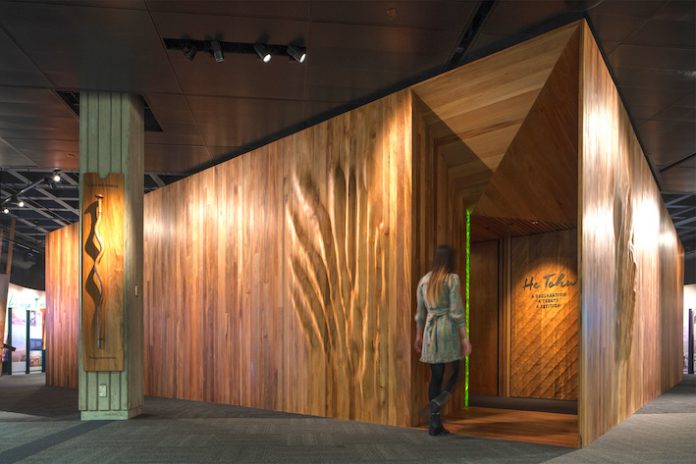Design professionals were honoured for their creativity and ingenuity at the 2018 NZ Wood-Resene Timber Design Awards evening in Auckland recently, which saw He Tohu Document Centre from Studio Pacific Architecture win the Supreme Award and Cymon Allfrey’s Family Bach a worthy runner-up.
“In a market crowded with grand designs and wonderful claims for every construction material, New Zealand timber is proving just how versatile and cost-effective it is,” Wood Processors and Manufacturers Association promotions manager Debbie Fergie says.
“These awards have again proved how imaginative design and structural integrity can combine to deliver beautiful timber buildings.”
Entrants competed in 10 categories, covering everything from residential and commercial architectural excellence to engineering innovation, multi-storey construction and student innovation.
“The 2018 NZ Wood-Resene Timber Design Awards showcase some of the best examples of innovation in timber design that New Zealand has to offer,” judges said.
“It’s evident there is great collaboration between architects, engineers, suppliers, fabricators and builders to produce some outstanding and highly innovative timber buildings and structures.
“The real stand-outs were those that went a step further, displaying a mature professional approach, an evocative sophisticated outcome, or a surprising twist.”
Entrants competed in 10 categories, covering everything from residential and commercial architectural excellence to engineering innovation, multi-storey construction and student innovation.
Structural performance and aesthetic excellence
Structural performance and aesthetic excellence were highlighted across all categories.
The Resene Supreme Award went to the iconic He Tohu Document Centre within the National Library, inspired by the form and function of a waka huia (treasure container).
“This is the perfect vessel to display the founding documents of Aotearoa,” the judges said.
“Highly developed manufacturing technologies are woven together with traditional timber materials, showcasing how timber can deliver technological, social and cultural value in a beautiful way.”
This entry also won the Niagara Timber Products’ Interior Innovation category.
Runner-up to the Resene Supreme Award was Cymon Allfrey’s Family Bach in Hanmer Springs.
“An interesting redefining of the family bach as a series of separate yet interrelated buildings with shared common spaces,” the judges commented. “A building where architecture hero’s wood, and wood has hero’d architecture.”
This entry also won the CHH Woodproducts Futurebuild Residential Architectural Excellence Award.
The Pukapuka Road house in Rodney won the NZ Farm Forestry Association’s NZ Specialty Timber Award, with the Walton House in Tauranga commended.
Public buildings
Both entries showed what could be done with locally-sourced timbers that “make the most of their natural performance capabilities, aesthetics and durability,” judges said.
Public buildings were a major feature of winning and commended entries.
TimberLab Solutions’ Commercial Architectural Excellence Award was won by Te Wharehou o Waikaremoana.
Judges admired how this “carefully considered building sits beautifully in its idyllic setting.”
By carrying through the conceptual ideas and references into every detail, both whenua and iwi are reflected,” they said.
It also won the Wood and Fibre Creativity Award, sponsored by Scion Research.
The XLam NZ Multi-Storey Timber Building Award is a new category, requiring entrants to submit projects at least three stories high, and was won by Te Pa Tauira-Otago Polytechnic Student Village in Dunedin.
It was the first five-storey, all-timber building in the country, with judges pointing out that the highly efficient modular layout enabled efficient offsite prefabrication which significantly reduced construction time, minimised waste and reduced cost.
The Mt Pleasant Community Centre won the NZ Timber Design Society’s Engineering Innovation category.
“By thinking differently about how timber products can be used for structural and interior cladding, the designers developed a system that was able to articulate much more than just a way of holding up the building through a seldom used yet highly efficient architectural form,” judges commented.
The Exterior Innovation and Infrastructure Award, sponsored by Taranakipine Woodspan, went to the Kumutoto Pavilion in Wellington.
“The distinctive anvil form of Kumutoto hovers dramatically over the layered purple heart decking, providing shelter at the edge of Wellington harbour,” judges said. “A fantastic student-led and delivered, collaborative project.”
Plant and Food Research’s Seafood Research Centre in Nelson won Nelson Pine Industries’ Excellence in Engineered Wood Products category.
Judges commented on the entire structure being prefabricated timber and featuring highly refined joint detailing.
“This shows how versatile timber can be for both structural and non-structural applications.”
Henry Fraser from the University of Auckland won Juken NZ’s Innovation of Student Design award, for his entry for the Newton Central Primary School in Auckland.
“This highly sophisticated presentation shows how holistic design can deliver a project that maximises performance, while minimising the impact on the natural environment,” judges commented.
Overall, the judges were delighted with the standard of entries, saying the awards showcased some of the best examples of innovation in timber design that New Zealand has to offer.
“The remarkable achievements of all contestants show how wood is the perfect material to deliver more sustainable and resilient buildings.
“It’s fantastic to see the growing use of local products such as CLT, glulam and LVL in a broader range of applications — with some stunning results.”
The four judges were Prefab NZ founder and chief executive Pamela Bell, BRANZ structural engineer David Carradine, Warren and Mahoney principal Tim Melville, and Scion sustainable architect Andrea Stocchero.
The keynote speaker at the Awards was Dr Helen Anderson, QSO. Ms Anderson has a PhD in seismology from the University of Cambridge, and 16 years of active research experience as a seismologist.
She has a professional and personal commitment to designing and building for the future, especially concerning the resilience of buildings in disasters, and how we manage risk from our heritage buildings.
Currently she is chair of the Building Research Association (BRANZ), Scion Research, the MBIE’s Building Advisory Panel, and a director of five other major organisations.




